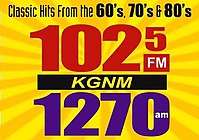KGNM
KGNM (1270 AM and FM translator K273BF 102.5 FM) is a radio station broadcasting a mainstream rock format, licensed to St. Joseph, Missouri, United States. The station is currently owned by Orama, Inc.[1]
| City | St. Joseph, Missouri |
|---|---|
| Frequency | 1270 kHz |
| Branding | St. Joe's KY102 |
| Slogan | Your New Rock Station |
| Programming | |
| Format | Mainstream rock |
| Ownership | |
| Owner | Orama, Inc. |
| History | |
| First air date | February 1, 1956 (as KUSN) |
| Former call signs | KUSN (1956–1981) |
| Call sign meaning | Good News Ministries |
| Technical information | |
| Facility ID | 50511 |
| Class | D |
| Power | 1,000 watts day 36 watts night |
| Transmitter coordinates | 39°44′39″N 94°47′16″W |
| Translator(s) | 102.5 K273BF (St. Joseph) |
| Links | |
| Website | KGNM website |
History

In 1955, Julius D. Spears, an Overland Park, Kansas real estate developer, obtained the construction permit for a new station in St. Joseph. KUSN went on the air on February 1, 1956 on 1270 kHz with 1 kW daytime only. The transmitter was at the present Leonard Road location, with studios at the historic Hotel Robidoux in downtown St. Joseph The Robidoux studios were previously used by KFEQ radio, and KVAK (later KAIR in Atchison.) In 1958, Spears sold the station to Kansas broadcast group owner Wyman Schnepp after being unable to make it financially viable. Schnepp sold the station only a few months later to Charles Norman, a St. Louis-area broadcaster. The studios moved to the fifth floor of the Howitt Building (also known as the KFEQ building) at 8th and Frederick Avenue, in studios also previously inhabited by KFEQ radio. Still unable to make the daytimer financially viable, the station was sold in 1959 to Midland Broadcasters, a company of Frederick Reynolds, who owned the facility until 1977. After the station's application to broadcast after sunset was denied by the FCC in 1960, the station launched an FM counterpart from the Howitt Building location, with 3 kW ERP on 105.1 MHz.
As an AM music format daytimer in the 1960s, the station struggled with ratings and competition from full-time AM, and later FM, stations in the St. Joseph and Kansas City markets. In 1967, the station moved from a Top 40 sound to middle-of-the-road music; two years later, in 1969, it flipped to country music. KUSN-FM simulcast the AM formats during much of the same period and also ran a beautiful music format. While the station was small, it had a strong impact on the market and was the launching pad for the early careers of many major market radio broadcasting personalities, including sportscaster George Michael, Skinny Bobby Harper (often attributed as the inspiration for the Dr. Johnny Fever character on WKRP), Rich "Brother" Robbin (who would work in radio in San Diego), and others.
In 1972, the station moved its studios and the FM transmitter to their present transmitter location. In 1974, KUSN-FM was increased to an ERP of 27.5 kW, new call letters KSFT were assigned, and the station was programmed with the Schulke automated beautiful music format. The station was sold to Hunter Broadcasting Group from Jacksonville, Illinois in 1977. Upon its sale in 1979 to Orama, the AM and FM combination was split up; the FM was sold to AM competitor KKJO at that time and became KKJO-FM, while KUSN became KGNM in 1981 after Orama was acquired by Good News Ministries.
From 1981 until 2013 KGNM was a Christian station. In 2013 Good News Ministries moved the religious programming to 91.1 FM and Orama installed a classic hits format on 1270. In May 2020 Orama agreed to sell KGNM and its translator to Eagle Radio, owner of St. Joseph's other four commercial stations (KFEQ, KKJO, KESJ, and KSJQ). <http://www.insideradio.com/free/deal-digest-fresno-ams-change-hands/article_c8d38548-9b40-11ea-9988-475bd5a01183.html>
On June 15, 2020 KGNM changed their format from classic hits to mainstream rock, branded as "KY102". The "KY102" branding was previously on KYYS 102.1 FM Kansas City from 1974 to 1997.[2]
Previous logo

References
- "KGNM Facility Record". United States Federal Communications Commission, audio division.
- Heritage KY102 Brand Comes To St. Joseph MO Radioinsight - June 16, 2020
External links
- KGNM in the FCC's AM station database
- KGNM on Radio-Locator
- KGNM in Nielsen Audio's AM station database
- K273BF in the FCC's FM station database
- K273BF on Radio-Locator
- FCC History Cards for KGNM